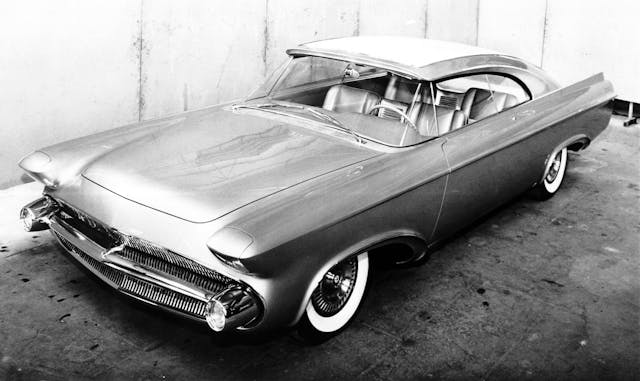The wonders of the Chrysler Norseman lie shipwrecked in the Atlantic
In the late-night hours of July 26, 1956, about 40 miles off the coast of Nantucket Island and nearing the end of its transatlantic journey from Italy to New York, the luxurious ocean liner SS Andrea Doria collided with another ship in heavy fog. Fifty-one people were killed, a number that would have been much higher had the Doria not remained afloat for 11 hours before it slipped below the water’s surface to its final resting place.
Considering the loss of life, less attention was given to the cargo that went down with the ship, but Chrysler Corporation quickly crafted a press release, matter-of-factly sharing the details of an “idea” car—the Norseman—that had been lost while making its way to America from Italian coachbuilder Carrozzeria Ghia.
Calling the car’s pillarless design “revolutionary,” the press release acknowledged that the Norseman “must be considered a complete loss.” And then, oddly, Chrysler shared that the car was “covered by insurance.” The New York Times reported that the automaker invested $200,000 into the project, the equivalent to $2.1 million today. What Chrysler didn’t say in its press release was that it could never recoup the time and effort that went into creating the two-door coupe: 50,000 hours of research and labor, two years in design, and another 15 months to build it. All gone, thanks to the the unfortunate confluence of bad weather and certain regrettable decisions.
SS Andrea Doria

The SS Andrea Doria was a source of great national pride when it was launched in 1951. Named for a 16th-century Genoese admiral, it was considered the largest, fastest, and (supposedly) safest of all Italian ships when it took its maiden voyage in January 1953. The opulent 29,100-ton ship had a normal capacity of 1200 passengers and 500 crew, and it had successfully completed 50 transatlantic voyages when it left the port of Genoa on July 17, 1956—with 1706 on board—and headed west to New York City. In an odd coincidence with the more famous RMS Titanic, which sank in 1912 during what was to be Captain Edward Smith’s final turn at the helm before retirement, Cpt. Piero Calamai was taking his final tour on the Andrea Doria before moving to its sister ship, the SS Christopher Columbo.
Nine days into the journey across the Atlantic Ocean and less than 300 miles from New York, dense fog made it difficult to see beyond the bow. Regardless, Calamai maintained a speed of more than 20 knots in the heavily trafficked area while the ship’s crew became completely reliant on radar.
MS Stockholm
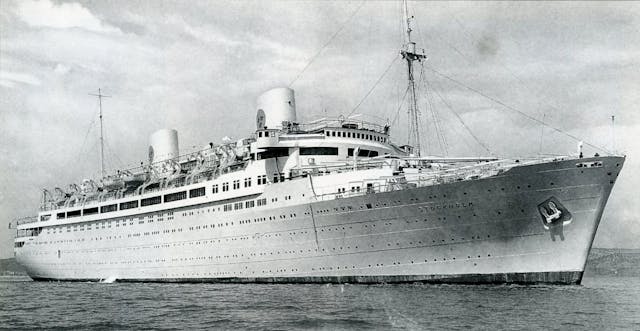
Meanwhile, the MS Stockholm, having recently left New York for Sweden, was fast approaching in the same shipping lane, heading east. The Stockholm, less than half the size of the Doria but designed with a reinforced ice-breaking bow, was also operating solely by radar due to the heavy fog.
Both ships were aware of the other as they drew closer, but it was later revealed that the Stockholm’s radar was set to a different range, so the Doria was actually closer to the Swedish ship than its crew realized. Nevertheless, it was Doria Cpt. Calamai’s decision to turn his ship to port—not starboard, in accordance with maritime rules—that proved fatal. With both ships turning in the same direction, the Stockholm struck the Doria at an almost 90-degree angle.
Chrysler Norseman
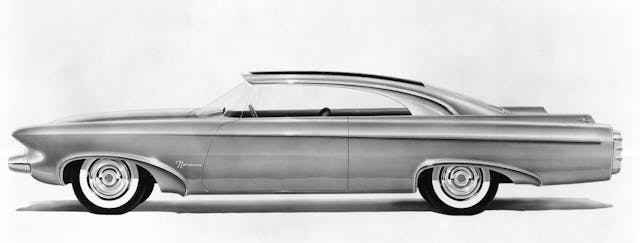
Below deck was the Norseman. Designed by Chrysler’s engineering division and built by Ghia, Chrysler claimed the concept “incorporated more structural, chassis, electrical, and styling innovations than any other ‘idea’ car every designed by Chrysler.”
The automaker’s press release added:
“Although the car was intended to have as great structural strength as today’s automobiles, it had no posts or pillars to support the roof. This was accomplished by means of structural cantilever arch, which curved upward from the rear of the frame and over the passenger compartment of the car.
“Glass surrounding the passenger compartment was uninterrupted, with the exception of the two arches of steel curving upward in the rear. In addition, there was a 12-square-foot panel of glass in the rook that was power operated and slid forward, leaving the roof over the rear seat open.
“All major body panels on the car were made of aluminum, as a result of research in advanced structural techniques to reduce weight. It had a sharply sloping hoof, unswept tail fins, and a covered, smooth underbody for aerodynamic efficiency.”
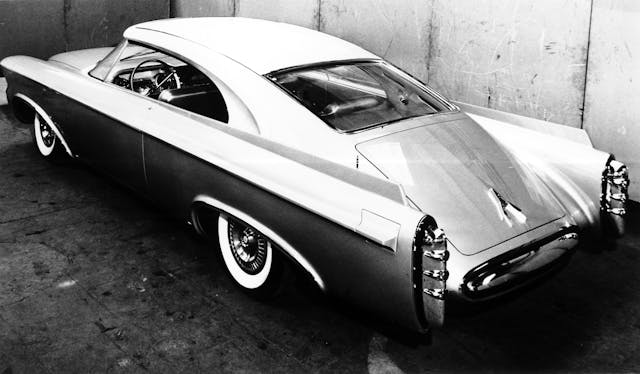
The Norseman was 227.5 inches long, had a 129-inch wheelbase, stood 57 inches tall, and was 80 inches wide. At the time, Chrysler kept details about the car’s engine a secret, describing it as “a special advanced Chrysler engine” with push-button PowerFlite transmission. Later accounts revealed that the mill was a 331-cubic-inch, overhead-valve V-8 rated at 235 horsepower.
The Chrysler press release continued by stating the Norseman had been painted “two-tone metallic green with a touch of red inside the flared wheel openings,” although William Brownlie, assistant manager of Chrysler’s design studio, remembered design chief Virgil Exner asking that it be silver. Italian journalists who saw the car before it shipped out recalled it being two-tone blue.
Description of the Norseman concluded, “Overall smoothness of the car was enhanced by concealed automatic headlights, door handles, and concealed trunk lid opening device.”
Few photos were taken of the “idea” car before it left Italy, as a full photo shoot and testing were planned upon its arrival in the U.S.
In the New York Times report published on August 5, 1956, journalist Bert Pierce quoted an anonymous Chrysler engineer, who said (in what sounded like something crafted by the marketing team), “Representing as it did a new attack on the frontiers of automotive engineering and styling, the Norseman had the ruggedness, boldness, and adventurous character of the Norse pioneers of old.”
Pierce reported that the roof “was designed and built so it could easily withstand the impact of eight times the weight of the car in case it rolled over.” He continued, “All features of the Norseman were described as designed with the forward look. As examples, the grille and front bumpers were in direct line to permit maximum cooling airflow with minimum aerodynamic drag.”
An unfortunate demise
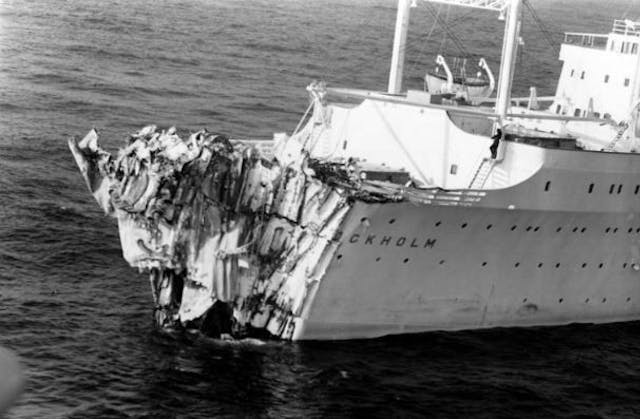
On July 26, 1956 at 11:10 p.m., the reinforced bow of the Stockholm tore a massive gash into the side of the Doria. Forty-six people aboard the Doria were killed—most of them upon impact—and five more died aboard the Stockholm. Although Cpt. Calamai would ultimately be held responsible for the collision, he was also commended for his calm leadership in the hours that followed. With the Doria listing severely to one side, half of the lifeboats were deemed unusable. Instead of creating panic by ordering the passengers and crew to abandon ship, Calamai correctly calculated that there was enough time for other boats to arrive at the scene and assist with a more orderly evacuation.
Immediately accepting blame and vowing to go down with the ship, Calamai had to be convinced by his crew to step into a lifeboat—but only after he was assured that no one else was still on board. Calamai never captained another ship, and he died a broken man in 1972.
Amazingly, the Stockholm was repaired and is still in use today. It has had 11 owners and 10 name changes since the collision, and it is now known as the Astoria.
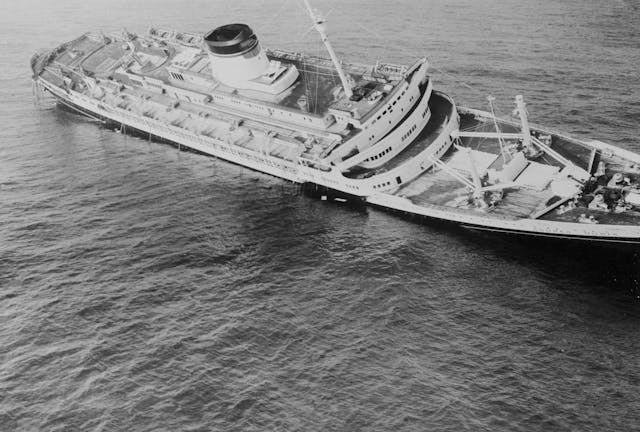
As for the Doria, it rests 260 feet below the ocean’s surface, lying on its starboard side, slowing succumbing to the ravages of time and salt. It has long been a tantalizing destination for scuba divers, but it is so dangerous that the wreckage is known as “the Mount Everest of dives.” According to a detailed account published by Hemmings in 2009, at least 14 divers have lost their lives while exploring the hulk. Two more have died since.
“The first divers reached the wreckage the day after the Andrea Doria’s tragic collision … and returned with photographs that they sold to Life magazine,” Hemmings’ Dave LaChance wrote. “They were the first of many who went down in search of treasure: jewelry from the first-class cabins, the contents of the pursers’ safes, place settings from the dining room. Only a few were aware of the presence of another treasure, one that by its sheer size was doomed to decay in the blackness of the ship’s hold: a show car known as the Norseman.”
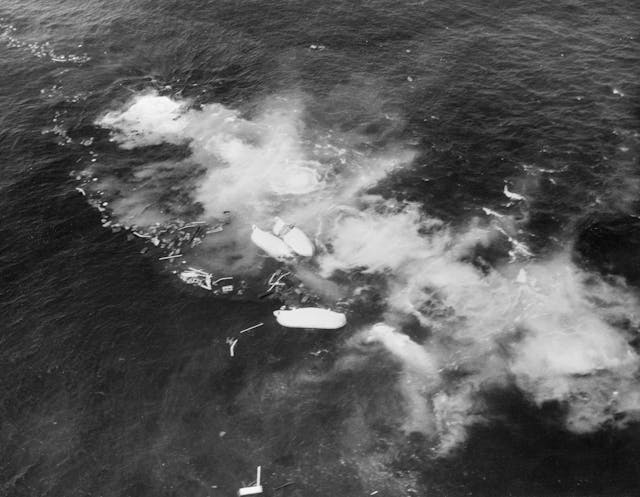
In the 1990s, underwater researcher David Bright wrote about finding the remains of the Chrysler concept car. “While looking for a lost diver, I had the had an opportunity to see the Norseman for myself in the cargo hold. Normally, all the passenger cars were placed in the garage section of the Andrea Doria, (which) is slightly aft of the collision point … These cars would have been placed onto the Doria by use of a crane and meticulously parked in the garage and arranged strategically for stability. However, the Norseman was no passenger vehicle, and it was specially packed and treated with extra care. The Norseman was put into a wooden crate and placed in the number 2 cargo area.”
Bright wrote at the time that the crate had disintegrated, “and the car was in very, very poor condition … Most of the car is rust, corrosion, and a heap of indistinguishable junk. The tires are still there and have assisted in its identification.”
He went on to explain the dangers of returning to the Doria for another look, and he said that although he’d returned to see it a couple of times, “I have not been back to this cargo site since 1994, and with all the decay that the wreck has had over the past 10 years, it is doubtful if I (or anyone else) will ever get a chance to see the remains of the Norseman again.”
Sadly, he was right. Bright was diving the Andrea Doria in July 2006, 50 years after the ship sank, when he suffered decompression sickness, went into cardiac arrest, and died at age 49. Another life lost to the disaster.
Although the loss of the Norseman is small in comparison—and fortunately some of the car’s design features were later incorporated into other Chrysler automobiles—we’re still left wondering what might have been. So too was that anonymous Chrysler engineer that the Times quoted in 1956. “Fate,” he said, “has denied the public the opportunity to see the wonders of the Norseman.”
It has not, however, been forgotten.
